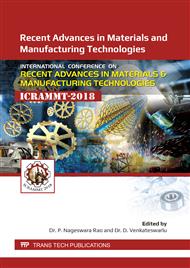[1]
Morton, Composites Volume 22, Issue 5, September (1991).
Google Scholar
[2]
Machinability of Natural Fibre reinforced composites: A review: Mahmoud M A Nassar, Ramanathan Arunachalam, Khalid I. Alzebdeh (11 June 2016).
Google Scholar
[3]
C.C. Tsao, H. Hocheng, The effect of chisel length and associated pilot hole on delamination when drilling composite materials, Int. J. Machine Tools Manuf. 43 (11) (2003).
DOI: 10.1016/s0890-6955(03)00127-5
Google Scholar
[4]
Maxwell, D., Young, R.J. and Kinloch, A.J, Hybrid particulate-filled epoxy-polymers : Journal of Materials Science Letters Vol 3, 9–12Composites, Volume 15, Issue 3, July (1984).
DOI: 10.1007/bf00720061
Google Scholar
[5]
Alberdi, A. Suárez, T. Artaza, G.A. Escobar-Palafox, K. Ridgway,Composite Cutting with Abrasive Water Jet, Original Research Article, Productional Engineering, Volume 63, (2013).
DOI: 10.1016/j.proeng.2013.08.217
Google Scholar
[6]
Tom sunny, J. Babu, Jose Philip,Experimental Studies on Effect of Process Parameters on Delamination in Drilling GFRP Composites,Procedia Materials Science, Volume 6, (2014).
DOI: 10.1016/j.mspro.2014.07.185
Google Scholar
[7]
M.A.J. Bosco, K.Palanikumar, B.D. Prasad, A.Velayudham, Influence of Machining Parameters on Delamination in Drilling of GFRP-armour Steel Sandwich Composites,Procedia Eng., Volume 51, (2013).
DOI: 10.1016/j.proeng.2013.01.108
Google Scholar
[8]
A.M. Abrão, P.E. Faria, J.C.C. Rubio, P. Reis, J. Paulo Davim Drilling of fibre reinforced plastics,Journal of Materials Processing Technology, Volume 186, Issues 1–3, 7 May (2007).
DOI: 10.1016/j.jmatprotec.2006.11.146
Google Scholar
[9]
Ho-Cheng H. A failure analysis of waterjet drilling in composite laminates. Int J Mach Tools Manufacturing (1990).
Google Scholar
[10]
Hashish M, Ramulu M, Kunaporn S, Posinasetti P. Abrasive waterjet machining of aerospace materials. In: 33rd International SAMPE Proceedings, vol. 33; (2001).
Google Scholar
[11]
Wang J. AWJ Machinig of polymer matrix composites-cutting performance, erosive process and predictive models. Int. J Adv Manufacturing Technology (1999).
DOI: 10.1007/s001700050129
Google Scholar
[12]
M.A. Azmir, A.K. Ahsan. A study of AWJ machining process on glass/epoxy composite laminate, Journal of Materials Processing Technology, Volume-209, Issue20,19 Nov-(2009).
DOI: 10.1016/j.jmatprotec.2009.08.011
Google Scholar
[13]
P.Jankovic, H. Oweinah, Influence of process parameters on blasting performance with the abrasive jet, in: Proc.10th Int. Symp. on Jet Technology, The Netherlands, (1990).
Google Scholar
[14]
T.U Siddiqui, Pradhan B. Effect of damage levels& curing stresses on delamination growth behavior in circular holes laminated FRP-composites. Compos ,A 2007;38:2412–21.
DOI: 10.1016/j.compositesa.2007.08.010
Google Scholar
[15]
E. Leema, Characteristics- surfaces machined with AWJ, EngJ Mater Technology 113 (1991).
Google Scholar
[16]
Izzet Karakurt, Garg A. Fracture behavior-graphite/epoxy laminates, Eng-FracMech 1985;22.
Google Scholar
[17]
Roxana Nedelcu,Marissen R, Westphal T, Sterk JC. Fracture of quasi-isotropic composite sheets with sharp notches. Compos Science Technology (2006).
DOI: 10.1016/j.compscitech.2005.10.020
Google Scholar
[18]
Rv shah,VelayudhamA., Krishnamurthy, R., and Soundarapandian, T., Evaluation of drilling characteristics of high volume fraction FRP composite,, IJMTM, (2004).
Google Scholar
[19]
Izzet Karaurt Finnie I, McFedden DH. On the velocity dependence of the erosion of ductile metals by solid particles at low angles of incidence. Wear (1978).
DOI: 10.1016/0043-1648(78)90147-3
Google Scholar
[20]
J. Wang Abrasive waterjet machining of polymer matrix composites-cutting performance, erosive process and predictive models. Int J Adv Manuf Technol (1999).
DOI: 10.1007/s001700050129
Google Scholar
[21]
Mahesh H, Pinnavaia TJ, Lan T, Wang Z, Shi H, Kaviratna PD. Clay-Reinforced Epoxy Nanocomposites:Synthesis, Properties & Mechanism of Formation. ACS series-(1996).
DOI: 10.1021/bk-1996-0622.ch017
Google Scholar
[22]
J.Njuguna, F.Ansari, V.M. Rodriguez, Nanomaterials, Nanofillers, and nanocomposites2014.
Google Scholar
[23]
Sivasaravanam.S,Akkapeddi MK, GFR olyamide-6 nano composites. Polymer. Composites.(2000).
Google Scholar
[24]
Roland L. Poveda, Nikhil Gupta, Electrical properties of carbon nanofiber reinforced multiscale polymer composites,Materials & Design, Volume 56, April (2014).
DOI: 10.1016/j.matdes.2013.11.074
Google Scholar
[25]
S.Sundaram Sandler JKW, Pegel S, Cadek M, A comparative study of melt spun polyamide-12 fibers reinforced with carbon nanotubes and nanofibers. Polymer. (2004).
DOI: 10.1016/j.polymer.2004.01.023
Google Scholar
[26]
R.K. Nayak, A.Dash, B.C. Ray, Effect of Epoxy Modifiers (Al2O3/SiO2/TiO2) on Mechanical Performance of epoxy/glass Fiber Hybrid Composites,Procedia Materials Science, Volume 6, (2014).
DOI: 10.1016/j.mspro.2014.07.115
Google Scholar
[27]
Faheem uddin Jawahar P, Balasubramanian M, Influence of nanosize clay platelets on the mechanical properties of glass fiber reinforced polyester composites. J. Nanosci. Nanotechnol.(2006).
DOI: 10.1166/jnn.2006.656
Google Scholar
[28]
Shivakumar Chandradass J, Kumar MR, Velmurugan R. Effect of nanoclay addition on vibration properties of glass fiber reinforced vinyl ester composties Materials (2007).
DOI: 10.1016/j.matlet.2007.02.009
Google Scholar
[29]
Kalpesh B. Sidhpuria, Hasmukh A. Patel, Parimal A. Parikh, Pratap Bahadur, Hari C, Bajaj, Raksh V. Jasra, Rhodium nanoparticles intercalated into montmorillonite for hydrogenation of aromatic compounds in presence of thiophene,Applied Clay Science, Volume 42, Issues 3-4, Jan (2009).
DOI: 10.1016/j.clay.2008.03.010
Google Scholar


